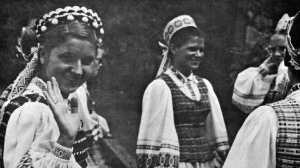Part II: Lithuanian Immigration to the United States
Post World War II Immigration
With Lithuania gaining independence and the enactment of laws in the United States restricting immigration, it was not until after World War II that another wave of immigrants came from Lithuania. This group, often called “displaced persons,” were fleeing Russian persecution as were their predecessors. Lithuania was first occupied by the Russians in 1940, as a result of the infamous Ribbentrop-Molotov Pact, and the result was mass deportation of Lithuanians to Siberia. With the invasion of Russia by the Third Reich, the Lithuanians overthrew the Russians before the Germans arrived. However, German occupation proved little better than Russian. But, with the second occupation of Lithuania by the Russians, many Lithuanians were forced to flee to the West due to their prior anti-Russian activities. Of this group, the greatest number, some 30,000, found their way to this country.[1] In the United States the law stipulated that each individual or family had to have a sponsor who would guarantee to maintain and find them a positiun in their newly adopted country. This the Lithuanian-Americans generously did.
Upon their arrival, the new group did not have to face as hostile a climate as did those during the mass immigration almost a century before. Lithuanian colonies, newspapers, churches, and schools were already well established. The new immigrants, who had had over two decades of independence from the Russians, were generally well educated; therefore it was easier for them to take advantage of the freedom offered in America. The fact that the older immigrants had already proven that Lithuanians were hard workers, frugal, and had a respect for education and the law was also an advantage.
These new Americans worked hard to gain a place of respect, while continuously fighting for the freedom of Lithuania. Many managed to find equitable positions in this country, but in some cases this was not possible, causing a good deal of hardship. For example, some individuals who held positions in legal, governmental, or medical fields had to take menial jobs since they were too old to spend the necessary time to study and pass mandatory exams. Despite this, many did go on, and a high percentage received advanced degrees.
The post-World War II immigrants tended to settle in the larger cities where Lithuanian communities already existed, with Chicago attracting the largest number. Others found their way to Cleveland, Detroit, Boston, New York, Philadelphia, and Los Angeles.
Since the end of World War II, few have been allowed to leave Russian occupied Lithuania, where freedoms are harshly suppressed. Of the few who managed to leave, the most famous was Simas Kudirka, who made international headlines when he sought asylum on a United States Coast Guard cutter. Unfortunately, due to governmental bureaucracy and bad judgment, he was severely beaten and taken back by the Russians to the Soviet fishing vessel. The incident created an uproar among Lithuanian-Americans, who soon began a campaign to free Kudirka. When it was discovered that his mother had been born in Brooklyn and returned to Lithuania as an American citizen, the arduous task was made easier. Finally, in 1974 the Russians consented to allow Simas Kudirka and his family to leave. The incident poignantly presents the suppressive conditions in the Russian occupied lands as sharply contrasted with the freedom found in America.

- L.E., X, 37. ↵
